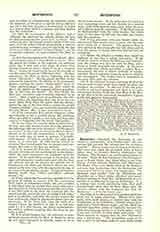

Hottentots. —Popularly the Hottentot is considered a man-monkey, or as Gibbon said “the connecting link between the rational and the irrational creation”. But he is not even the lowest of the three chief races into which the aboriginal tribes of South Africa may be divided—Bantus, Hottentots, and Bushmen. The Bushmen are usually placed lowest in the scale. When the first Europeans (the Portuguese) came to South Africa, they found what is now Cape Colony divided between Bushmen and Hottentots. The Bantu tribes were chiefly north of the Zambesi, and were finer in physique than the Hottentots, but possessed of less brain power and imagination. The Bushmen were smaller than the Hottentots and altogether on a lower plane—physical and moral. There is nothing to show that the Hottentot was incapable of assimilating European civilization. It is a curious fact, worth mentioning here, that skull measurements show that of these three races the greatest affinity with the European lies with the Bushman, i.e. with the lowest type.
The origin of the Hottentots is a question which has given rise to much discussion. Efforts have been made, with small success, to connect them with the Troglodytes or cave-dwellers. Several writers have suggested a North African origin; and Dr. Bleek has detected important points of similarity between the Hottentot language and those of North Africa; but it is too soon to build on these slight indications. Dr. Theal appears to suggest that the first Hottentots were a mixed race. “The probability seems to be that a party of intruding males of some slight brown or yellow race took to themselves women of Bushman blood, and thus gave origin to the people whom Europeans term Hottentots.” This suggestion merely puts this question among the insoluble problems.
For the description of the pure Hottentot we are dependent on ancient writers like Kolben; because the pure Hottentot cannot be said to exist today. He was slightly below the average European: the upper limbs undeveloped and the lower muscular, high cheek bones, thick lips, nose fiat, eyes wide apart, hair black and crisp in tufts, color yellowish brown. Today the so-called Hottentots are of every color, size, and character, through mixture with other races. Even the language which they principally speak is a patois of the Dutch dialect of the Cape.
The language of the Hottentots is monosyllabic; having four known dialects—the Namaqua, which is still spoken by some of the natives; the Kora and Cape Hottentot, which are practically extinct; and the Eastern Hottentot, which exists only in a few meager vocabularies, and has been extinct for some time.
The most striking characteristic of the Hottentot language for the European lies in the “clicks”. Something similar is thought to be found in the Galla language of Abyssinia, in the Circassian tongue, and in the ancient speech of Guatemala. But three-fourths of the words in the Hottentot dialects begin with a click. Clicks are of four kinds, and are difficult to describe to those who have not heard them. The drawing of a cork, and the gurgling sound of water in the narrow neck of a bottle, the sound made in urging a horse to trot or run, and other sounds have been used to illustrate their nature; but at least one of them, the palatal click, defies description.
The grammatical system of the Hottentots is built almost exclusively on sex-denoting suffixes, and it is the most complete of this small group of languages. The liquid L is entirely wanting, and it has a small variety of clear nasal consonants. The only native literature that exists in these dialects consists of folk-lore tales, such as mark the beginning of all European literature. Translations of parts of the Scriptures have been made by missionaries in Namaqualand.
The religion of the Hottentots is a congeries of superstitious observances, of which travellers and folklorists have never been able to obtain a full explanation from the natives. They appear to believe in a superior being whom they call Tsuikwap; but the antiquity and the meaning of this word are open to some doubt. The most elaborate ceremonies of the Hottentots are in honor of the moon, and they pay great reverence to cairns of stones and wood, where they believe a mythical personage named Heitsi-Eibib to reside.
The Hottentots called themselves Khoikhoin—men of men. The most curious of their customs is that on attaining manhood the Hottentot makes himself a monorchis. Polygamy was not general, but permitted to the wealthy. They never seem to have made boats of any kind, and abhor the oil of fish, although fond of smearing their skin with oil. Witch-craft was common among them. Their government was carried on by chiefs, who administered a well-defined native law. The doctors were in high esteem, and next to them the priests, who combined the duties of masters of ceremonies and surgeons in the monorchist rites.
Hottentots are now found chiefly in German Southwest Africa and in Cape Colony. For the former territory there are no official figures as to their number; but they do not exceed thirty thousand. During the recent rebellion against the Germans, the Hottentots gave more trouble than all the other races together.
In the time of the first Dutch governor (van Riebeeck) the Hottentots at the Cape were estimated at150,000. But the smallpox epidemic in 1713 reduced their numbers enormously. In 1904 the census put them at 85,892. Their destiny seems to be absorption into the more virile native races.
Missionary work among the Hottentots and allied tribes has been undertaken by the Oblates of St. Francis de Sales in Cape Colony, and the Oblates of Mary Immaculate in German Southwest Africa. The Orange River Vicariate is composed chiefly of a species of Hottentot called Griquas or Bastards. In German territory, in the Prefecture Apostolic of Lower Cimbebasia, Catholic missionary work among the native tribes is in its infancy.
SIDNEY R. WELCH

